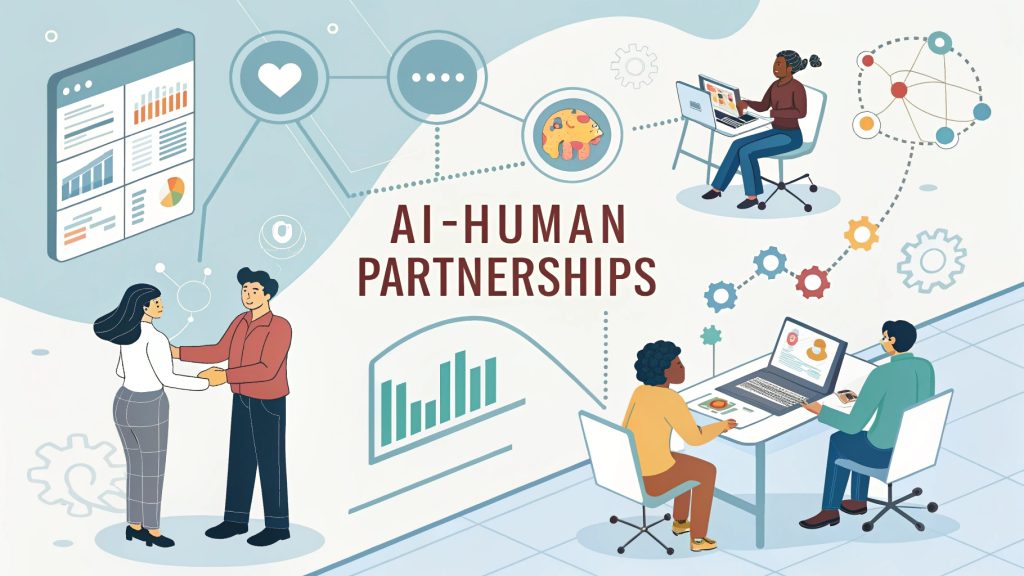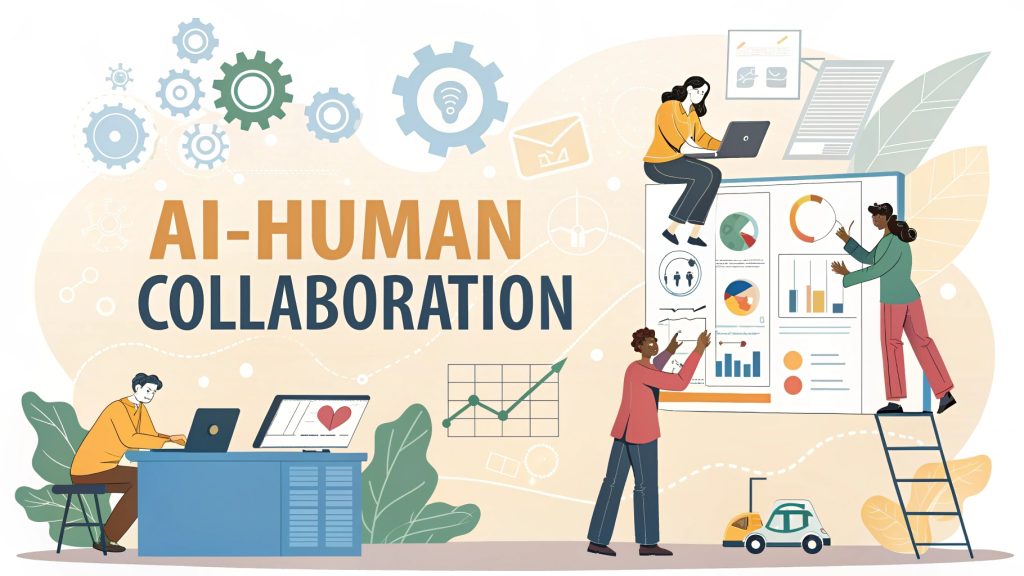
What if the key to future success isn’t choosing between humans or AI, but combining them? As technology reshapes teams, leaders must rethink how to boost productivity by enhancing workflow with AI. This article explores real-world strategies, common mistakes, and powerful insights to help leaders build stronger, smarter human-AI collaborations. Curious how to lead better with AI? Let’s dive in.
Understanding the importance of AI-Human teamwork for leaders
Did you know that teams combining AI with human skills are outperforming traditional teams? Leaders who embrace this dynamic are boosting productivity and enhancing workflow with AI faster than ever. In this section, you’ll discover why understanding this shift isn’t optional—it’s essential. Stick around to explore the game-changing role of leadership in this powerful partnership.
Why leaders can’t ignore AI-Human collaboration
Imagine trying to win a soccer match with half your team sitting on the bench. That’s what it’s like when leaders ignore the power of AI-human teamwork. AI can do things humans can’t, like crunch data in seconds, but it needs people to guide it. When both sides work together, productivity skyrockets. Leaders who get this will move ahead faster than those who don’t.
How AI enhances workflow and team productivity
AI is like a super-fast assistant. It helps teams save time by automating boring tasks, finding patterns in messy data, and even suggesting smart decisions. That means people can focus on creative ideas, problem-solving, and helping others. When used well, AI isn’t just a tool, it’s a team player that boosts how smoothly everything runs.
“AI doesn’t replace workers, it empowers them to do more of what humans do best.”
Common challenges leaders face when introducing AI
Think introducing AI is as easy as downloading an app? Think again. Many leaders face tough challenges from team resistance to unclear roles. These roadblocks can slow down productivity and limit how well AI enhances your workflow. This section breaks down the most common problems and helps you spot them before they mess up your AI-human collaboration journey.
Resistance to change within the team
Let’s face it, most people don’t love change. When AI shows up, some team members get nervous. Will it make their jobs harder? Will they be replaced? Leaders must understand these fears and handle them with care. If not, fear can lead to pushback and poor results.
Unclear roles between humans and AI
When it’s unclear who’s doing what, chaos happens. If team members don’t know whether they or the AI should make a decision, things can stall. Leaders need to clearly define what AI does and where human judgment takes over. Clear roles = smooth teamwork.
Lack of technical knowledge among decision-makers
Some leaders don’t feel confident with AI because they don’t understand it. But you don’t have to be a programmer to lead AI projects. You just need to ask the right questions and work with experts who do know the tech. Good leadership is about vision, not writing code.
Essential leadership skills for guiding AI-Human collaboration
AI alone won’t transform your team but leadership will. To truly boost productivity and enhance workflow with AI, leaders must develop new skills. From emotional smarts to digital confidence, this section dives into the must-have qualities leaders need today. Ready to lead the future? Let’s explore what that takes.
Strategic thinking and digital literacy
AI doesn’t magically fix problems, it needs direction. Leaders must think strategically : Where will AI have the biggest impact? Which tools are right for the job? Understanding the basics of how AI works (even just at a surface level) helps make smarter choices.
Emotional intelligence and team communication
AI can analyze data, but it can’t listen with empathy or understand feelings. That’s where humans shine. Leaders need strong emotional intelligence to support their teams, manage emotions around change, and keep communication open and honest.
Encouraging a culture of innovation
If people feel scared to try new things, they’ll never unlock the full power of AI. Leaders must create a safe space for experimentation, where it’s okay to fail, learn, and grow. Innovation only happens when teams feel trusted and supported.
Real-life examples of AI improving workflow with human input
What happens when humans and AI actually team up in the real world? Magic. In this section, we’ll look at industries like healthcare and retail where productivity is booming thanks to smart AI-human teamwork. These case studies will show you how AI enhances workflow when people lead the way.
Healthcare : Smarter diagnoses with AI support
Doctors now use AI to analyze X-rays and patient data. The AI finds patterns that a human might miss. But doctors still make the final call. This mix of machine speed and human care leads to faster, more accurate diagnoses and better treatment for patients.
Retail : Personalizing the customer journey
Stores use AI to recommend products based on shopping habits. A person might see suggestions online that feel almost magical. But behind the scenes, it’s AI learning their preferences. Human marketers then fine-tune campaigns, adding emotion and creativity AI can’t provide.

Manufacturing : Reducing waste through predictive AI
Factories use AI to predict when machines will break or when supplies will run low. This avoids delays and reduces waste. Workers use these predictions to plan better and fix problems before they even happen. It’s a win-win for productivity and the planet.
Building trust between teams and AI tools
Would you trust a teammate who made decisions without explaining why? Neither would most people. Trust is the glue that holds AI-human partnerships together. This section uncovers why trust matters and how leaders can help their teams feel confident using AI tools to boost productivity and workflow.
Transparency in how AI makes decisions
Would you follow advice from someone who never explains their thinking? Probably not. That’s why it’s important to make AI decisions transparent. If a tool recommends something, teams should know why. Understanding the “why” builds trust.
Training and upskilling for AI literacy
Using AI without training is like giving someone a smartphone without instructions. Leaders should offer hands-on workshops, tutorials, and mentoring. When people know how to use AI, they use it well and feel good doing it.
Setting realistic expectations for AI output
AI is powerful, but it’s not magic. It can make mistakes, especially if the data is bad. Leaders should set realistic goals. Expect improvement, not perfection. That way, teams won’t feel let down and they’ll be more open to using AI long-term.
Best practices to boost productivity through AI-Human teamwork
Want to know how top teams get real results from AI? It’s all about habits and strategy. This section reveals practical best practices that make AI-human collaboration work from starting small to keeping humans in control. If your goal is enhancing workflow with AI, these tips are your roadmap.
Start small with pilot projects
Trying to use AI everywhere at once is like learning 10 new apps in one day, it’s overwhelming. Smart leaders start with small pilot projects. Test, learn, improve. Once a small project works, it’s easier to grow from there.
Collect feedback and adapt workflows
Leaders should always ask: “How’s this working for you?” Regular check-ins help improve AI tools and team workflows. It’s not just about the tech, it’s about the experience of the people using it.
Keep humans in control of final decisions
No matter how smart AI gets, humans should have the final say. AI gives data and suggestions, but only people can add judgment, context, and emotion. Keeping human oversight ensures smarter, more balanced outcomes.
How to measure the impact of AI-Human collaboration
If you can’t measure it, you can’t improve it. When it comes to productivity and enhancing workflow with AI, leaders need smart ways to track progress. This section walks you through metrics and feedback strategies that show how well your AI-human teamwork is performing and where you can grow next.
Quantitative metrics for workflow improvement
Leaders need numbers to see if things are working. Useful metrics include:
- Time saved on routine tasks
- Error reduction rates
- Project completion speed
- Cost savings over time
Tracking these over time shows where AI is helping and where adjustments are needed.
Qualitative feedback from teams
Data matters, but feelings do too. Ask team members how they feel about using AI. Are they more confident? Do they feel supported? Combining hard data with soft insights gives the full picture of how well the collaboration is going.
Ongoing evaluation and adjustment
Don’t “set it and forget it.” AI-human teamwork needs regular review. Leaders should schedule updates every few months to tweak tools, update training, and respond to feedback. The more teams evolve with AI, the more productive they become.
Future trends in enhancing workflow with AI-Human partnerships
The future of work isn’t human or AI, it’s both. From cobots to adaptive AI, tomorrow’s teams will look very different. In this section, we explore what’s coming next and how leaders can stay ahead by embracing ethical, intelligent partnerships that take productivity to a whole new level.
Adaptive AI systems tailored to team needs
Future AI tools won’t just follow orders, they’ll adapt to team preferences. If a team likes a certain way of working, AI will adjust. It’s like having a teammate who learns your style and gets better every day.
Collaborative robots (cobots) and intelligent assistants
In factories and offices, cobots (collaborative robots) work safely beside people. They lift, scan, and sort while humans focus on thinking and planning. Digital assistants will also get smarter, helping write reports, book meetings, and remind you of deadlines without being annoying.
Ethical leadership in an AI-enhanced world
With great power comes great responsibility. Leaders must think about fairness, privacy, and how AI affects jobs. Making sure AI is used ethically builds trust with teams and with customers. Responsible leadership = long-term success.
AI-human teamwork isn’t a trend, it’s the future of getting things done smarter. From building trust to measuring success, leaders play a key role in enhancing workflow with AI. Ready to take the next step? Share this post, spark a conversation, or explore our other guides to stay ahead in the productivity revolution. Your leadership could shape the future of work.


